Intraoperative systemic vascular resistance is associated with postoperative nausea and vomiting after laparoscopic hysterectomy
2020-04-08MengDiQuMengYuanZhangGongMingWangZhunWangXuWang
Meng-Di Qu, Meng-Yuan Zhang, Gong-Ming Wang, Zhun Wang, Xu Wang
Meng-Di Qu, Meng-Yuan Zhang, Gong-Ming Wang, Zhun Wang, Xu Wang, Department of Anesthesiology, Shandong Provincial Hospital Affiliated to Shandong First Medical University,Jinan 250021, Shandong Province, China
Abstract BACKGROUND The incidence of postoperative nausea and vomiting (PONV) in patients undergoing laparoscopic hysterectomy is very high compared with other surgeries, even when many prophylactic measures have been taken. However, the pathogenesis of PONV is multifactorial. Female sex, a history of motion sickness or PONV, nonsmokers, and perioperative opioid use are the most closely related factors. Among the multiple risk factors, suboptimal gastrointestinal (GI)perfusion may be attributed to some cases of PONV, and increased systemic vascular resistance (SVR) may lead to GI ischemia. The hypothesis of this research was that SVR is related to PONV.AIM To investigate the relationship between SVR and PONV in patients undergoing laparoscopic hysterectomy.METHODS A total of 228 patients who underwent elective laparoscopic hysterectomy were included in this prospective observational study. SVR was monitored using a noninvasive hemodynamic monitoring system. Four indices of SVR, the baseline,mean, area under the curve (AUC), and weighted AUC, were used for analysis.The incidence and severity of nausea and vomiting were evaluated while patients were awake and throughout the intervals from 0 to 2 h, 2 to 6 h, and 6 to 24 h starting upon arrival at the post-anesthesia care unit. The associations between various SVR indices and PONV were investigated by logistic regression. P < 0.05 was considered statistically significant.RESULTS The incidence of PONV in the study was 56.14% (128/228), and PONV tended to appear within 6 h after surgery. Five variables were significant in univariate analyses, however, only SVR mean [odds ratio (OR) = 1.015, 95%CI: 1.005-1.109, P= 0.047] and duration of surgery (OR = 1.316, 95%CI: 1.003-2.030, P = 0.012) were associated with PONV after logistic regression analysis. Furthermore, patients with high SVR mean were more likely to suffer from PONV after laparoscopic hysterectomy. On average, patients who developed PONV needed more time to tolerate diet and demonstrated poorer sleep quality on the first night after surgery.CONCLUSION In this study, PONV was a common complication after laparoscopic hysterectomy. SVR was associated with PONV, and high SVR mean was associated with a significantly increased risk of PONV.
Key Words: Postoperative nausea and vomiting; Systemic vascular resistance;Gastrointestinal perfusion; Laparoscopic hysterectomy; Prospective observational study;Pneumoperitoneum
INTRODUCTION
Postoperative nausea and vomiting (PONV) is defined as nausea, retching or vomiting that occurs within 24 h after an operation, remaining prevalent despite the utilization of various antiemetic measures. The incidence of PONV after general anesthesia is approximately 30%[1]and can be as high as 80% after gynecological laparoscopic surgery[2]. The consequences of PONV include patient discomfort, additional postoperative complications, prolonged hospitalization, and increased health care costs[3]. The pathogenesis of PONV is multifactorial, and its etiology and pathogenesis are not clear.
Suboptimal gastrointestinal (GI) perfusion may be responsible for some cases of PONV[4]. Insufficient GI perfusion leads to an increase in serotonin release in the GI tract, which induces PONV by stimulating the chemoreceptor trigger zone adjacent to the vomiting center[5-7]. However, currently, GI perfusion cannot be easily and continuously monitored in patients. Optimal systemic vascular resistance (SVR) is essential for the perfusion of any metabolically active tissue bed, such as the GI tract[8].Increased SVR is related to suboptimal GI perfusion, and reducing SVR can significantly improve GI perfusion[9,10]. We used intraoperative SVR values to reflect GI perfusion in this study.
The aim of this prospective observational study was to observe the associations between SVR and PONV in patients undergoing laparoscopic hysterectomy in order to provide new ideas for the treatment of PONV. We chose laparoscopic hysterectomy because patients undergoing this operation demonstrate a higher incidence of PONV[2]. We excluded patients with a history of smoking and motion sickness or PONV, since these are the main factors affecting PONV[11]. Furthermore, there were risk factors for suboptimal GI perfusion and increased SVR in our study population,including surgical stress, body tilting[12], pneumoperitoneum[12]and vasopressor use[13].The hypothesis was that SVR is related to PONV.
MATERIALS AND METHODS
This was a prospective, observational, single-cohort study. The study was approved by the Ethics Committee of Shandong Provincial Hospital Affiliated to Shandong First Medical University (NO. 2018-052). Both verbal and written informed consents were obtained from patients before surgery.
Patients
A total of 304 patients aged between 18 and 65 years who underwent elective laparoscopic hysterectomy (American Society of Anesthesiologists status I–II) from February 2018 to June 2019 at the Shandong Provincial Hospital participated in this study. The exclusion criteria were as follows: (1) Patient refusal; (2) Emergency surgery; (3) History of smoking; (4) Prior history of PONV or history of motion sickness; (5) Vaginal or abdominal (open) hysterectomy; (6) Concurrent GI surgery; (7)Chemotherapy or radiotherapy before surgery; (8) Antiemetic medication administered in the hospital within 24 h before surgery; (9) Intensive care unit admission after surgery; and (10) Significant cardiovascular, neurologic, psychiatric,pulmonary, or hepatic diseases.
Anesthesia
In the operating room, following the establishment of standard monitoring including electrocardiography, pulse oximetry, and noninvasive blood pressure, continuous noninvasive arterial blood pressure measurement was established using the noninvasive hemodynamic monitoring system LiDCO (LiDCO Ltd., Cambridge,United Kingdom). Anesthesia was then induced using intravenous dexamethasone,lidocaine, sufentanil, and propofol, and a tracheal tube was placed facilitated by cisatracurium administration. Anesthesia was typically maintained by total intravenous anesthesia using an intravenous infusion of propofol and remifentanil,avoiding inhalation anesthetics. Bispectral index monitoring was used to control the depth of anesthesia to prevent intraoperative awareness. All patients received intravenous ondansetron (4 mg) for PONV prophylaxis towards the end of surgery,and a patient-controlled venous analgesia (PCVA) device was connected to the patient before entering the post-anesthesia care unit. For PCVA, we utilized sufentanil instead of butorphanol and ondansetron based on our clinical experience.
SVR monitoring
SVR was monitored using the LiDCO rapid monitor. Monitoring and data recording started before anesthesia induction and stopped at the end of surgery. The monitor was positioned at the back of the anesthesia machine, blinded to the anesthesia team.The SVR data were captured every 2 s by a research computer. The average minute values of the measurements were used for SVR index derivation. Four indices of SVR were derived, the baseline (the patient was awake and breathing room air), mean, area under the curve (AUC), and weighted AUC values. The AUC was the sum of the differences between the baseline and the data point of every minute that was higher than the baseline (Figure 1). The weighted AUC was calculated by dividing the AUC by the time of the recording.
Postoperative nausea and vomiting
Nausea was defined as a subjective unpleasant sensation associated with the urge to vomit. Retching was defined as the labored, spastic, and rhythmic contraction of the chest and abdominal muscles without expulsion of gastric contents. Vomiting was defined as the forceful expulsion of gastric contents from the mouth. Patients subjected to any of the signs and symptoms of nausea, retching, or vomiting within 24 h after surgery were diagnosed with PONV in this study. The incidence and severity of nausea and vomiting were evaluated while patients were awake and throughout the intervals from 0 to 2 h, 2 to 6 h, and 6 to 24 h starting upon arrival at the postanesthesia care unit. Nausea severity was evaluated using the nausea visual analog scale.
Statistical analysis
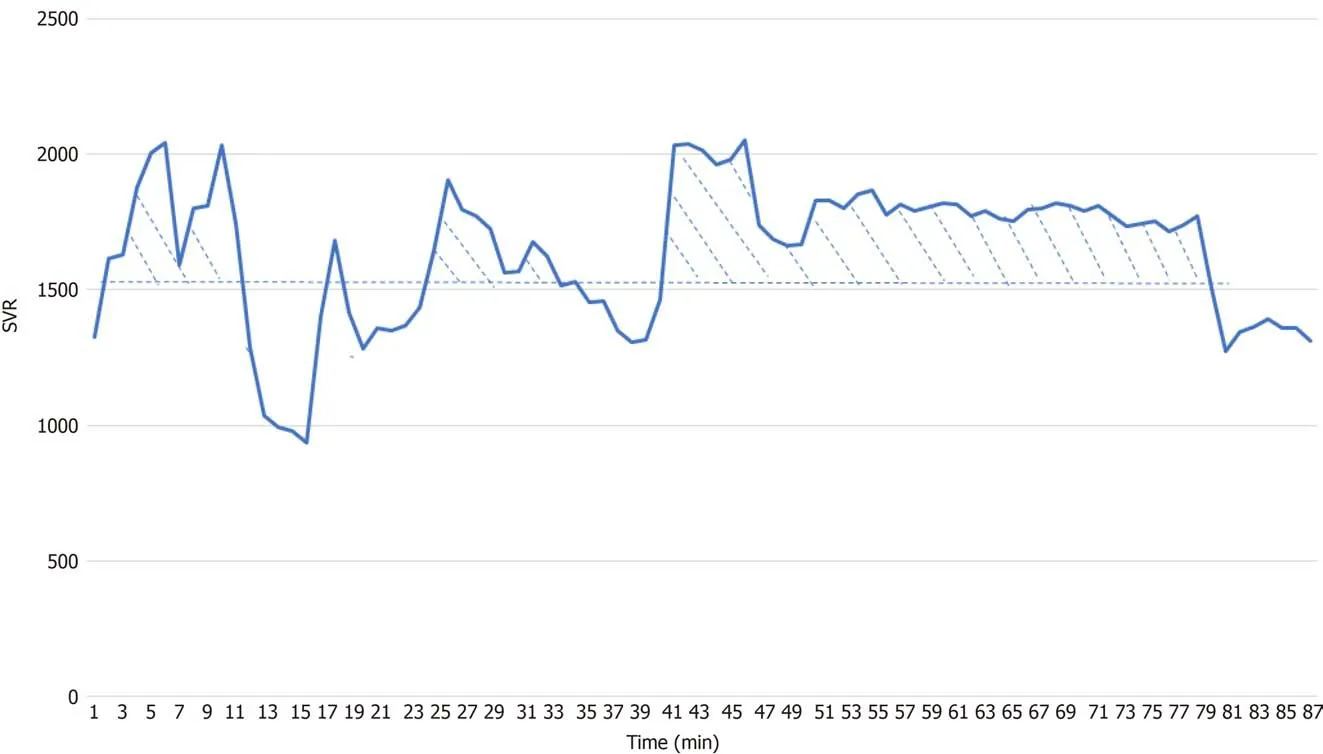
Figure 1 Systemic vascular resistance trace from one patient. SVR: Systemic vascular resistance.
Logistic regression requires adequate sample content. Generally, an effective sample size is 10 to 15 times the number of covariates. Sixteen covariates were included in this study, and the required sample size was at least 16 × 15 = 240. Considering the incidence of PONV, we decided to recruit 300 patients. Continuous variables are presented as the mean ± SD or median and interquartile range (P25, P75). Data were compared with the use of independent samplest-tests or Mann-WhitneyUtests.Categorical variables are presented as the number of patients (percentage). Data were compared with the use of theχ2test. We used log transformation to adjust the AUC and weighted AUC. The effect of SVR on the occurrence of PONV was assessed with the use of binary logistic regression analysis. Initially, SVR indices and perioperative variables were evaluated for univariate association with PONV. After the collinearity test, variables that were significant in univariate analyses (P< 0.1) were included in a binary logistic regression model. We choseP< 0.1 to analyze more variables in subsequent analysis.P< 0.05 was considered statistically significant. All statistical analyses were performed with the SPSS statistical package, version 24.0, Chicago, IL,United States.
RESULTS
A total of 304 patients underwent elective laparoscopic hysterectomy during the study period and matched the selection criteria. Among the eligible patients, 228 gave written consent and were enrolled in the final analysis (Figure 2). The perioperative variables of all enrolled patients are listed in Table 1.
A total of 128 patients developed PONV after surgery, resulting in an overall PONV rate of 56.14%. Among patients who developed PONV, in 57.03% of the cases, the first appearance of PONV occurred roughly within 6 h after surgery, a time that is consistent with previous observations[14].
Five variables that were significant in univariate analyses (P< 0.1) were consecutively subjected to a logistic regression analysis (Table 2). As a result, duration of surgery [odds ratio (OR) = 1.316, 95%CI: 1.003-2.030,P= 0.012] and SVR mean (OR 1.015, 95%CI: 1.005-1.109,P= 0.047) were identified as independent predictors of PONV (Table 2, Figure 3). Notably, high SVR mean was associated with a significantly increased risk of PONV in this study (Figure 4).
Comparisons between patients with and without PONV showed that the former group needed more time to tolerate diet and demonstrated poorer sleep quality on the first night postoperatively (Table 1).
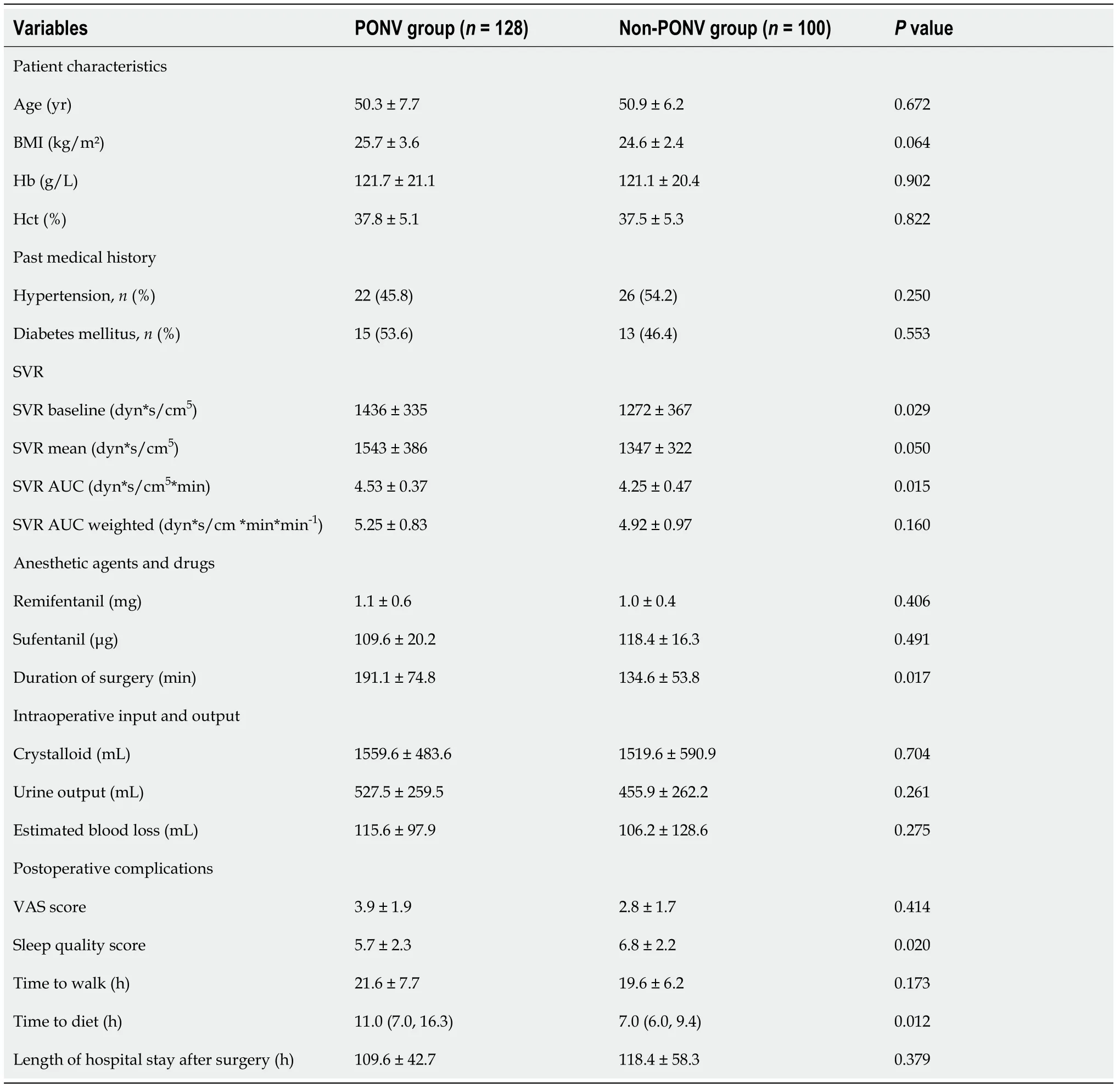
Table 1 Perioperative variables
DISCUSSION
There are many factors affecting PONV, including patient-, anesthesia-, and surgeryrelated factors. Female sex, a history of motion sickness or PONV, nonsmokers, and perioperative opioid use are the most closely related factors[15]. This prospective observational study showed that SVR was associated with PONV in patients undergoing laparoscopic hysterectomy. In addition, patients with high SVR mean were more likely to develop PONV.
Maintenance of tissue perfusion is one of the prerequisites for the proper functioning of any organ[16]. Suboptimal tissue perfusion, depending on the severity and duration, can cause organ dysfunction and increase morbidity and mortality[17].Suboptimal GI perfusion may be responsible for some cases of PONV[4]. The GI tract is the most vulnerable to hypoperfusion of the whole body[18]. The tissue bed of the GI tract is metabolically active; however, it has minimal to no autoregulatory capacity[19]and is notoriously intolerant of even a brief period of ischemia[20]. It has been reported that one of the important mechanisms of PONV is the release of serotonin due toinsufficient GI perfusion and the resulting ischemia[5-7]. Fasting before elective surgery will cause hypovolemia and GI ischemia in patients, and they are more prone to PONV. Crystal or colloid fluid for intravenous rehydration before surgery can significantly reduce the incidence of PONV[21]. Other studies have found a correlation between the occurrence of PONV and the increase in serotonin levels. Patients with PONV have higher levels of serotonin metabolites in their urine[22]. These results show the relationship between PONV, GI perfusion, and serotonin.

Table 2 Predictors of postoperative nausea and vomiting
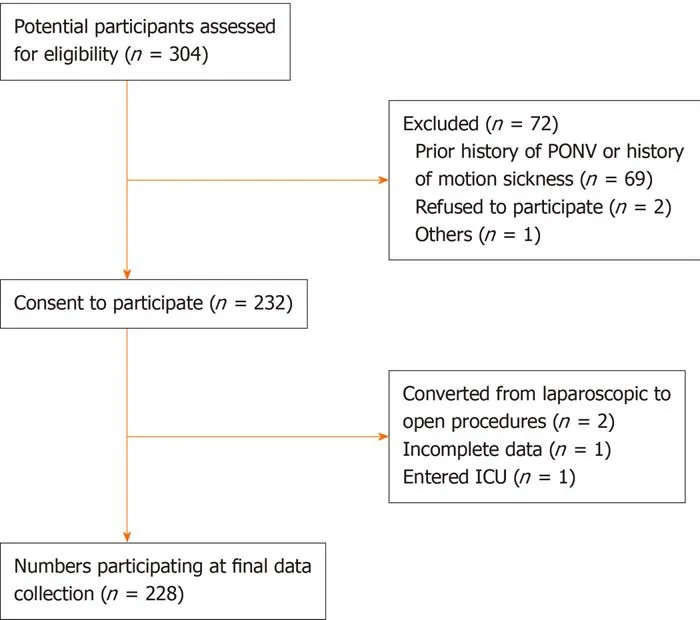
Figure 2 Flow chart of the study. PONV: Postoperative nausea and vomiting; ICU: Intensive care unit.
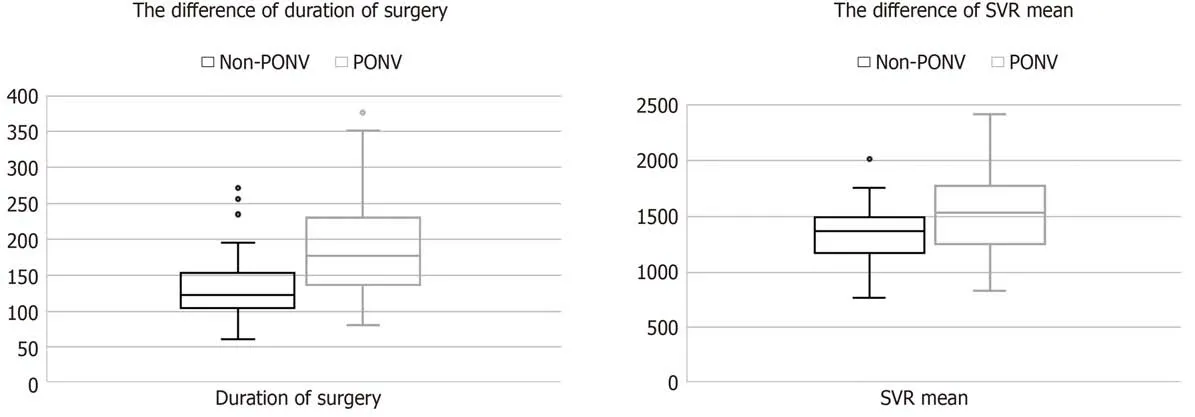
Figure 3 Independent predictors of postoperative nausea and vomiting. SVR: Systemic vascular resistance.
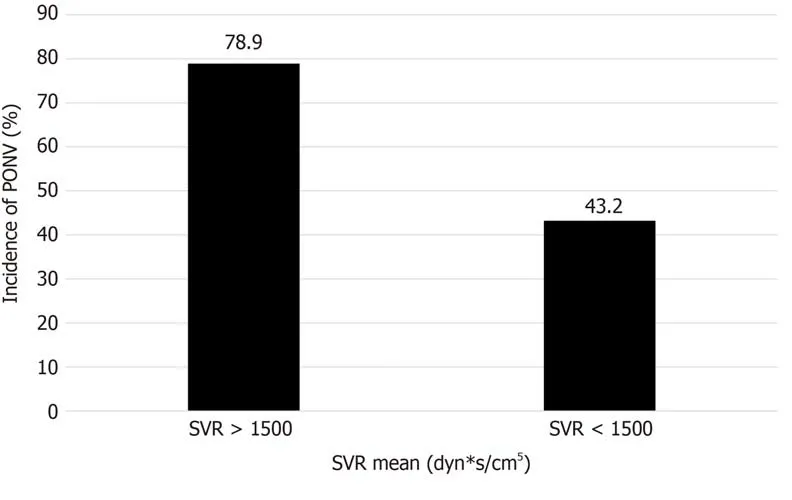
Figure 4 Incidence of postoperative nausea and vomiting between different levels of systemic vascular resistance mean. SVR: Systemic vascular resistance; PONV: Postoperative nausea and vomiting.
Furthermore, PONV is more common in patients undergoing laparoscopic surgery.Carbon dioxide pneumoperitoneum has been proposed as a potential cause[23].Compared with traditional laparotomy, CO2pneumoperitoneum used in laparoscopic surgery more easily causes increased intra-abdominal pressure and compresses the GI tissue mucosa, reducing blood flow[24-26]. Then, more serotonin is released, which may stimulate the chemoreceptor trigger zone through the GI vagal nerve, consequently leading to PONV[27]. In this study, after pneumoperitoneum was established, SVR increased significantly. After surgery was completed, SVR basically returned to preoperative levels (Figure 1). This shows that pneumoperitoneum during laparoscopic surgery leads to tissue hypoperfusion, which can be reflected by the increase in SVR.
According to our observations, higher SVR mean increases the risk of PONV. It is suggested that we could reduce SVR levels to relieve GI mucosal pressure during surgery, thereby reducing the incidence of PONV. SVR is an index calculated from the mean arterial pressure, right atrial pressure, and cardiac output. The normal value is generally 900-1500 dyn*s/cm5. In this study, SVR often increased under the premise of normal blood pressure. Moreover, the cardiac output decreased, which may also explain why increased SVR is related to tissue hypoperfusion.
The duration of surgery remains an independent risk factor for PONV, which is consistent with some previous studies[28]. The opioid doses administered during the perioperative period have not been shown to be related to PONV. This may be related to the fact that the patient will stop PCVA when PONV occurs. In this regard, we should pay attention to counseling patients before surgery, not to reducing the discomfort caused by PONV at the cost of pain. We also found that the visual analog scale scores of PONV patients were worse than those of non-PONV patients, which may be related to the patients’ tolerance and subjective experience. However, the occurrence of PONV was not associated with the length of hospitalization. PONV generally occurred within 24 h after surgery, and it was not the main factor that determined the time of discharge.
This study has several limitations. One major limitation is that PONV diagnosis mainly depends on the subjective symptoms of patients, thus lacking objective indicators for measurement. Another limitation is that this was a single-cohort observational study. Therefore, a causal effect of SVR on PONV could not be determined. Whether SVR monitoring-guided care can improve PONV cannot be determined by this study. Although the accuracy of the LiDCO rapid monitoring system has been shown in cardiac surgery patients, whether SVR has reference significance remains to be investigated[29].
CONCLUSION
In summary, duration of surgery and SVR mean were associated with PONV after laparoscopic hysterectomy. Patients with high SVR mean were more likely to develop PONV. Although we administered prophylactic therapy, the incidence of PONV in this study remained very high. The complexity of the pathogenesis makes the prevention of PONV more difficult, and the current lack of animal experimental models that can replace humans is also a prominent concern in the research process.We need to actively explore and constantly look for measures that can reduce the occurrence of PONV.
ARTICLE HIGHLIGHTS
Research background
Postoperative nausea and vomiting (PONV) remains prevalent after general anesthesia, especially after gynecological laparoscopic surgery. The pathogenesis of PONV is multifactorial, and its etiology and pathogenesis are not clear. Suboptimal gastrointestinal (GI) perfusion may be responsible for some cases of PONV, and there are risk factors for suboptimal GI perfusion in patients undergoing laparoscopic hysterectomy. Furthermore, increased systemic vascular resistance (SVR) is related to suboptimal GI perfusion. However, there is currently no research on the relationship between SVR and PONV.
Research motivation
Female sex, a history of motion sickness or PONV, nonsmokers, and perioperative opioid use are the most closely related risk factors for PONV. Suboptimal GI perfusion may be attributed to some cases of PONV, and an increased SVR may lead to GI ischemia. The present study analyzed the relationship between SVR indices and PONV after laparoscopic hysterectomy, which may assist in the prevention of PONV in the future.
Research objectives
The aim of this prospective observational study was to observe the associations between SVR and PONV in patients undergoing laparoscopic hysterectomy. Four SVR indices, the baseline, mean, area under the curve (AUC) and weighted AUC, were assessed through logistic regression analysis. Moreover, we compared the outcomes of PONV patients and non-PONV patients.
Research methods
We performed a prospective observational study of patients undergoing laparoscopic hysterectomy.
Research results
The incidence of PONV after laparoscopic hysterectomy in our institution was 56.14%,and PONV mostly occurred roughly within 6 h after surgery. SVR mean and duration of surgery were associated with PONV. High SVR mean was associated with a significantly increased risk of PONV in this study. Furthermore, patients who developed PONV needed more time to tolerate diet and demonstrated poorer sleep quality on the first night after surgery.
Research conclusions
SVR mean and duration of surgery were associated with PONV after laparoscopic hysterectomy. Patients with high SVR mean were more likely to develop PONV.
Research perspectives
Although we administered many prophylactic measures, the incidence of PONV remained very high, especially after gynecological laparoscopic surgery. More randomized controlled trials should be performed to explore precautions that can reduce the occurrence of PONV.
杂志排行
World Journal of Clinical Cases的其它文章
- Relationship between non-alcoholic fatty liver disease and coronary heart disease
- Remission of hepatotoxicity in chronic pulmonary aspergillosis patients after lowering trough concentration of voriconazole
- Endoscopic submucosal dissection as alternative to surgery for complicated gastric heterotopic pancreas
- Observation of the effects of three methods for reducing perineal swelling in children with developmental hip dislocation
- Predictive value of serum cystatin C for risk of mortality in severe and critically ill patients with COVID-19
- Sleep quality of patients with postoperative glioma at home
